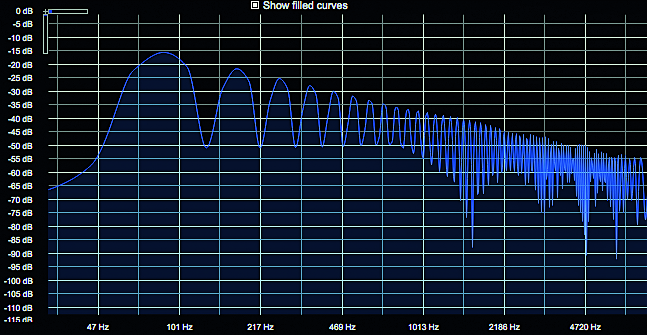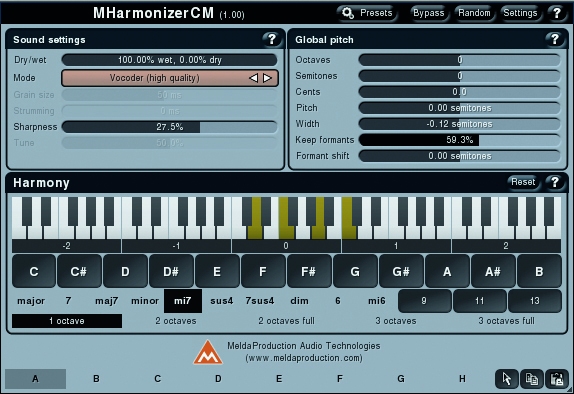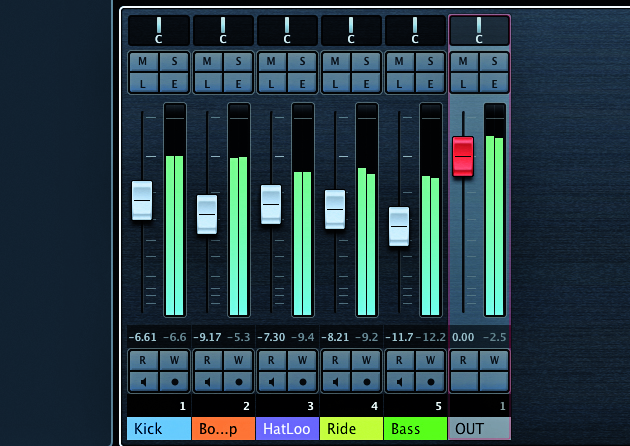The A to Z of computer music: H
Our compendium of production terms moves on to the letter H

Ever had a question about harmonics, hertz or headroom? Or wondered how best to use hi-hats, hysteresis or hard syncing? H is for...
Hard clipping
When an audio signal exceeds the limits of a digital system, it clips, completely flattening the waveform at the threshold. This is known as hard clipping. Soft clipping, on the other hand, eases into the clipping, rounding off the waveform so that any threshold violations are smoothly curved rather than brutally flattened.
Hard disk drive
While a Mac or PC's random access memory (RAM) serves as essential temporary storage for real-time operational data, amongst other things, the hard disk drive is the primary storage system, maintaining its contents even when the host computer is powered down. A hard disk comprises one or more non-magnetic platters coated in magnetic material, spinning at (usually) 5400, 7200 or 10,000rpm.
Although most conventional computers will host at least one internal hard drive that stores the operating system and any installed applications, additional drives can be attached via USB, FireWire, Thunderbolt or External S-ATA for the storage of documents and media, including- pertinently for the computer musician - sample libraries and ROMpler soundbanks.
Today, the HDD faces increasingly stiff competition from flash memory-based solid state drives (SSDs), which offer the benefits of faster data access and no moving parts. With SSD technology rapidly falling in price, it's only a matter of time before the HDD goes the way of magnetic tape.
Hard sync
Many virtual analogue synthesisers offer hard sync as an option in their oscillator sections. When activated, one oscillator is designated the 'master' while another is designated the 'slave'.
Whenever the master oscillator completes a wave cycle, the slave oscillator begins its wave cycle again from the start too, no matter where in the cycle it may have been at the point of retriggering. By offsetting the frequency of the slave oscillator, we get a harmonically rich, edgy tone that works particularly well for lead lines and hard basses.
Want all the hottest music and gear news, reviews, deals, features and more, direct to your inbox? Sign up here.
Harmonics
A series of mathematically predictable frequencies present above the fundamental frequency of a (musical) audio signal that serve as essential components of the overall sound.
Harmonics are spaced apart equally by an amount dependent on the fundamental. The note A4 above middle C, for example, is at 440Hz, with harmonics at 880Hz (A5), 1320Hz (E5), 1760Hz (A6), etc - so the harmonic frequencies are multiples of the fundamental.
Perhaps slightly confusingly, the first such frequency above the fundamental is the 'second harmonic', as the fundamental is considered to be the 'first harmonic'. An understanding of harmonics is essential in sound design (particularly involving synthesisers) and mixing (with regard to EQ, specifically). Sounds may also contain inharmonic frequencies; that is, non-musical or dischordant tones such as noise mixed into a synth sound, and these are not multiples of the fundamental frequency.

Harmonisation
The process of composing a chordal accompaniment to a leading melody.
Harmoniser
An audio effects processor that pitchshifts its input signal and overlays the results on top of the original in order to generate a two-or-more-part harmony. The original harmoniser was Eventide's H910 hardware unit, released in 1974, and the American company still own the rights to the Harmonizer trademark today.

Harmony
When two or more notes played or sung at the same time sound pleasing to the ear due to their concordant harmonic relationship (eg, a major chord), they are said to be 'in harmony'. Chords that don't seem to fit together in such a pleasant way are said be 'dissonant', but this doesn't necessarily mean they aren't musically relevant or that they aren't part of harmony theory.
Headroom
In practical terms, headroom is the amount you can boost a particular audio signal before the system it's playing through will distort - in other words, the difference in level between the signal's loudest point and the maximum level the system can handle.
If you find that the master output is clipping in your DAW, lowering its level fader attenuates the signal level and increases the headroom, giving you more 'room' to add further sounds to the mix that might raise the overall level further.

Hertz (Hz)
Defined as "the number of cycles per second of a periodic phenomenon", hertz (named after the physicist Heinrich Hertz) is the unit of frequency in the International System of Units (SI).
The pitch of a soundwave is defined by its frequency in hertz, with a signal at 440Hz generating the note A4, for example. Synthesiser oscillators, filters and EQ, LFOs... numerous elements of your DAW and plugins deal directly with the frequency of sound or modulation waves (generating or shaping them), all described in Hz and kHz (kilohertz - thousands of hertz).
The clock speeds of various components in your computer are also described in hertz, of course - these days, they'll most likely be up in the gigahertz (GHz - billions of hertz) range.
Hexadecimal
Also known as 'hex' or 'base 16', hexadecimal is a numeric system that most musicians will never encounter - unless, that is, they use tracker software.
While the numbers 0-9 are self- representing, the numbers 10-15 are represented by the letters A-F. Trackers are programmed by entering values into a grid (that you can loosely think of as analogous to your DAW's arrange page and MIDI editor combined) to specify note data and parameter changes. Most trackers use a hex numbering scheme for efficient representation of values in a limited space.
High-pass filter
A filter that attenuates (lowers) the level of all frequencies below its cutoff point (thus letting all those above it through), the high-pass filter (or the high-pass mode on a multimode filter) can be used correctively to reduce low-end rumble and sub bass, or creatively for upward sweeps, general sound design, etc.
A high-pass filter often features a resonance control for applying boost to the frequencies directly around the cutoff point, and the amount of attenuation is determined by the number of 'poles' in the filter, each one adding 6dB of attenuation for every octave the signal moves away from the cutoff frequency.
So, a 4-pole high-pass filter lowers the volume of the signal by 24dB for every octave below the cutoff point.

Hi-hats
A pair of small cymbals mounted, facing each other, on a stand and brought together via a footpedal, the hi-hats are one of the three main components of the drum kit, along with the bass (kick) and snare drums.
Very generally speaking, while the kick and snare provide the main beat (boom, crack, boom boom, crack, etc), the hi-hat is held closed and struck with a stick on eighth- or 16th-notes, filling out the groove - a core drumming technique known as 'riding'.
Played closed, the sound of the hi-hats is tight and bright; played open, they become much bigger and more splashy; and when brought together by depressing the pedal, the hi-hats make a soft "chick" sound that can be very useful for accenting the off-beat when riding the ride cymbal instead, or playing with brushes on the snare (in jazz, primarily).
Electronic music also uses hi-hat sounds, though almost always of the programmed, non-realistic variety.
Hiss
Related to hum but not as controllable, a certain level of hiss is inevitable in even the most software-based studio, since the amplifiers in or connected to your loudspeakers can't help but generate a certain level of it.
Other causes of hiss include poor quality and/or unbalanced cables, and recording instruments and microphones at too low a level, which bring up the noise floor and hiss when the playback level is raised to compensate.
Hit
A short, one-shot percussive sample, eg, a drum.
Hum
Not the hair-wrenching issue it once was thanks to the proliferation of integrated digital systems, hum in the recording studio (beyond the low- level noise intrinsic in the transformers of any electronic audio equipment) is caused by various undesirable processes including ground loops, CRT monitors and shared impedances.
The fix depends on the cause, but fortunately, it's not something the computer musician has to worry about too much these days, since virtual instruments and effects don't generate noise of any kind (unless they're designed to!).
Hysteresis
In audio, hysteresis is a parameter found on some noise gates, used to reduce 'chatter' when the input signal hovers around the threshold level. To implement it, two thresholds are applied: one to open the gate when the signal exceeds it, and the other, a few decibels below the first, to close it when the signal drops below it. The gap between the two prevents the constant opening or closing of the gate by signals hovering around either.
Computer Music magazine is the world’s best selling publication dedicated solely to making great music with your Mac or PC computer. Each issue it brings its lucky readers the best in cutting-edge tutorials, need-to-know, expert software reviews and even all the tools you actually need to make great music today, courtesy of our legendary CM Plugin Suite.
